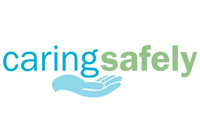 When Brenda Lively, Registered Nurse at Princess Margaret Cancer Centre, did her usual rounds to check on patients in the 14B Bone & Marrow Transplant (BMT) Inpatient Unit, she noticed something different about the way one patient's Hickman line was fastened to her gown.
When Brenda Lively, Registered Nurse at Princess Margaret Cancer Centre, did her usual rounds to check on patients in the 14B Bone & Marrow Transplant (BMT) Inpatient Unit, she noticed something different about the way one patient's Hickman line was fastened to her gown.
A Hickman line is a central venous catheter most often used to administer chemotherapy or other medications, as well as to withdraw blood for analysis. Typically, a safety pin is used to secure the Hickman line to a patient's gown or clothing, but unit staff members were noticing the safety pin wasn't as safe as its name would suggest.
"The concern with the pin is you can poke through the Hickman line and damage it," says Zarna Patel, Registered Nurse on unit 14B. "Patients or staff can injure themselves while adjusting the safety pin, and in a worst-case scenario there is a chance the patient could bleed out if it punctures the line."
Despite potential safety issues associated with the pin, it has continued to be used because an unsecured Hickman line poses a greater risk than one that is fastened into place.
Brenda observed that the patient had an innovative way to attach the line to her gown using a badge clip – a clip identical to the one holding Brenda's own UHN ID badge.
After inquiring how the patient had come up with the idea, Brenda learned the patient was an ICU nurse educator at another hospital. Being familiar with seeing the badge clip, the patient thought it might be a better substitute for the safety pin.
Brenda brought the idea to the unit's Safety Huddle – a daily check-in on the unit where staff have the opportunity to raise safety concerns with their team and manager and work toward solutions.
The group agreed a safer device was needed to replace the safety pin, so Susan Clarke, Nurse Manager of the Inpatient BMT Units & Autologous Transplant Day Hospital, asked Zarna to bring the issue to the Transplant Nursing Practice Council to find replacement options.
The Council is made up of two nurses from 14B, two from the Autologous Transplant unit, and a representative from the Nursing Resource Unit. The group meets monthly to discuss safety concerns and practice improvement issues.
Finding a solution
While various devices exist, many can be quite expensive given the quantity needed and the frequency that the clip must be changed to comply with infection control protocols.
"We looked into a few products on the market, and the badge clip seemed to be the most cost-effective option, but most importantly safe," Zarna says. "We tested the clip on a dummy as well to see how it would stand up to various movements and it seemed to work well."
The Council brought the option to Pamela Savage, Director of Professional Practice, and consulted with the Infection Prevention and Control team to ensure the badge clip would meet the necessary standards.
After testing and approvals, the badge clip system has now been rolled out on the unit to test it with more patients and the team is happy with the results.
Zarna says having a forum to voice safety concerns so they can be addressed right away has been very helpful.
"The Safety Huddle is really good because before this safety issues would only be discussed at our monthly staff meetings which aren't as frequent, so sometimes people forget or no one is tasked with following up on the issue," she says.
"Now you're writing down the issues and there's a plan along with it about what actions are being taken and what's being followed up on. It stays on the safety huddle board until it's resolved.
"This process has been really helpful in bringing about change."
